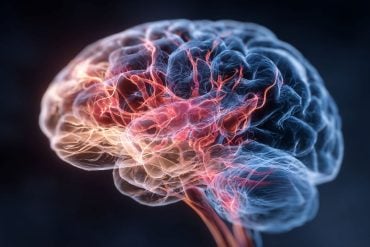Summary: A massive international genetic study has uncovered rare, high-effect variants in three specific genes—MAP1A, ANO8 and ANK2—that dramatically increase the likelihood of developing ADHD. These variants, though extremely uncommon, strongly affect genes expressed in dopaminergic and GABAergic neurons, influencing brain development from fetal life onward.
Individuals with ADHD who carry these variants also show lower IQ scores and reduced educational and socioeconomic outcomes. The findings mark a major step toward identifying concrete biological mechanisms and future therapeutic targets for ADHD.
Key Facts:
- Rare High-Impact Variants: MAP1A, ANO8 and ANK2 variants raise ADHD risk up to 15-fold.
- Neuron Disruption: The variants affect dopaminergic and GABAergic neurons tied to attention and impulse control.
- Life Outcomes: Carriers show lower IQ, reduced educational attainment, and lower socioeconomic status.
Source: Aarhus University
ADHD is a neurodevelopmental disorder with a high heritability, in which the genetic component consists of thousands of genetic variants. Most variants only slightly increase the likelihood of receiving the diagnosis.
Now an international study led by researchers from iPSYCH at Aarhus University has shown that rare high-effect genetic variants also play an important role.
The study has been published in Nature, and the researchers have found a markedly increased likelihood of developing ADHD among individuals carrying rare variants in three genes – MAP1A, ANO8 and ANK2 – in some cases by up to 15 times.
These genetic variants are very rare, but when present, the study shows that they strongly affect genes expressed in the brain’s nerve cells. In individuals carrying these variants, the development and communication between nerve cells may therefore be disrupted, which can result in ADHD.
“We can now, for the first time, point to very specific genes in which rare variants confer a high predisposition to developing ADHD,” says Professor Anders Børglum from the Department of Biomedicine at Aarhus University, who is the senior author of the study.
“The identified variants very likely have a highly damaging effect on the genes, and they show us precisely which genes and fundamental biological mechanisms may be affected,” he continues.
Affects the brain from foetal life into adulthood
By combining genetic data with data on how genes are expressed in different cell types in the brain, the researchers have shown that the rare variants involved in ADHD particularly affect the function of dopaminergic and GABAergic neurons. These cell types help regulate attention, impulse control and motivation.
The effects can be traced as early as foetal life and continue into adulthood.
“Our findings support that disturbances in brain development and function are central to the development of ADHD,” explains Ditte Demontis, Professor at the Department of Biomedicine at Aarhus University and first author of the study.
“We have also analysed which proteins interact with the proteins encoded by the three identified ADHD genes, and we have identified a larger protein network that also plays a role in other neurodevelopmental disorders – including autism and schizophrenia. This provides insight into the biological links across several psychiatric diagnoses,” she says.
Implications for IQ, education and employment
The rare genetic variants not only affect who develops ADHD but also influence how individuals with ADHD fare in the education system and labour market.
By linking genetic data to Danish registry data, the researchers found that individuals with ADHD who carry the rare variants have, on average, lower educational attainment and socioeconomic status than those without the variants.
Among adults with ADHD, an average reduction in IQ score of around 2.25 points was observed for each rare high-risk variant they carry.
“This suggests that individuals generally face greater cognitive challenges if they have ADHD due to these rare genetic variants, which may have educational and occupational consequences,” says Jinjie Duan, postdoctoral researcher in the Aarhus group and co-first author of the paper.
“This is only the beginning”
The findings broaden our understanding of the biological underpinnings of ADHD and may lay the groundwork for future treatment.
“The study provides a new and concrete direction for mapping the biological mechanisms involved in ADHD, because we now know causal genes with high-effect variants. They give us insight into some of the fundamental biological processes, which can guide the design of deeper mechanistic studies – for example, to identify new therapeutic targets,” says Anders Børglum.
Jinjie Duan adds:
“Yes, and we are only at the beginning of uncovering these rare high-effect variants. Our calculations show that there are many more rare causal variants that can be identified in even larger studies. In the current study, we can already point to 17 additional genes with rare variants that are very likely to be causal.”
Behind the research results
- The study is a genetic analysis of nearly 9,000 individuals with ADHD from the Danish iPSYCH cohort and 54,000 without ADHD, combined with analyses of brain cell function and Danish registry data on education and socioeconomic status.
- The main finding is that rare variants in MAP1A, ANO8 and ANK2 confer up to a 15-fold increased risk of ADHD. The rare variants involved in ADHD particularly affect genes expressed in the brain and dopaminergic and GABAergic neurons, and carriers have, on average, lower educational attainment, socioeconomic status and IQ.
- The study is led by researchers from Aarhus University in collaboration with the Broad Institute of MIT and Harvard (USA), Radboud University (the Netherlands), University Hospital Würzburg (Germany), among others.
- It has received external funding from the Lundbeck Foundation, the Novo Nordisk Foundation and several international funders.
- The results have undergone peer review and are published in Nature.
Key Questions Answered:
A: They identified rare, high-effect variants in MAP1A, ANO8 and ANK2 that can raise ADHD risk by up to 15-fold.
A: They disrupt genes active in dopaminergic and GABAergic neurons from fetal life through adulthood, affecting attention, motivation and impulse control.
A: Yes. Carriers show lower average IQ, reduced educational attainment, and lower socioeconomic status.
Editorial Notes
- This article was written by a Neuroscience News editor.
- Journal paper reviewed in full.
- Additional context added by our staff.
About this ADHD and Genetics research news
Author: Jakob Christensen
Source: Aarhus University
Contact: Jakob Christensen – Aarhus University
Image: The image is credited to Neuroscience News
Original Research: Open access.
“Rare genetic variants confer a high risk of ADHD and implicate neuronal biology” by Anders Boerglum et al. Nature
Abstract
Rare genetic variants confer a high risk of ADHD and implicate neuronal biology
Attention deficit hyperactivity disorder (ADHD) is a childhood-onset neurodevelopmental disorder with a large genetic component. It affects around 5% of children and 2.5% of adults, and is associated with several severe outcomes. Common genetic variants associated with the disorder have been identified, but the role of rare variants in ADHD is mostly unknown.
Here, by analysing rare coding variants in exome-sequencing data from 8,895 individuals with ADHD and 53,780 control individuals, we identify three genes (MAP1A, ANO8 and ANK2; P < 3.07 × 10−6; odds ratios 5.55–15.13) that are implicated in ADHD.
The protein–protein interaction networks of these three genes were enriched for rare-variant risk genes of other neurodevelopmental disorders, and for genes involved in cytoskeleton organization, synapse function and RNA processing.
Top associated rare-variant risk genes showed increased expression across pre- and postnatal brain developmental stages and in several neuronal cell types, including GABAergic (γ-aminobutyric-acid-producing) and dopaminergic neurons.
Deleterious variants were associated with lower socioeconomic status and lower levels of education in individuals with ADHD, and a decrease of 2.25 intelligence quotient (IQ) points per rare deleterious variant in a sample of adults with ADHD (n = 962).
Individuals with ADHD and intellectual disability showed an increased load of rare variants overall, whereas other psychiatric comorbidities had an increased load only for specific gene sets associated with those comorbidities.
This suggests that psychiatric comorbidity in ADHD is driven mainly by rare variants in specific genes, rather than by a general increased load across constrained genes.







